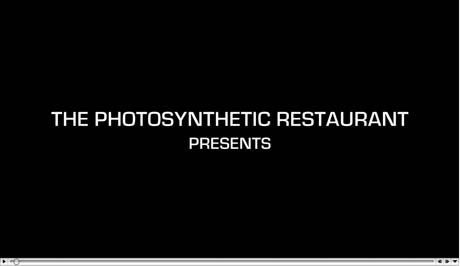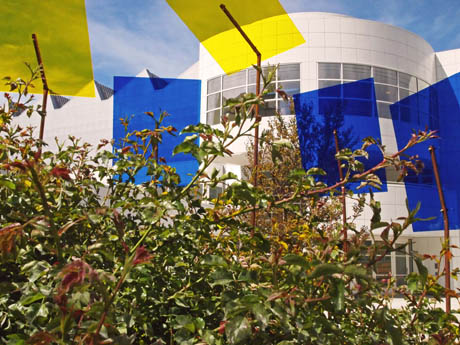
IMAGE: The Photosynthetic Restaurant at the Crocker Museum of Art, photo by Jonathon Keats.
On Saturday, April 16, the world’s first photosynthetic restaurant for plants opened for business. Located outside the Crocker Museum for Art in downtown Sacramento, the new dining establishment is a project of experimental philosopher and artist, Jonathon Keats. This is not a restaurant for humans to eat plants; rather, it is an exercise in creating a dining experience for the plants themselves, with a menu of enhanced sunlight that is designed to appeal to their sophisticated sensory apparatus, providing them with not only energy, but also a satisifying, piquant, and delightful experience.
“Honestly I’m surprised that nobody else has done this,” declared Mr. Keats in the accompanying press release, tongue firmly in cheek. “For nearly a half billion years, plants have subsisted on a diet of photons haphazardly served up by the sun and indiscriminately consumed, without the least thought given to culinary enjoyment.”
If cooking did indeed make us human, then Chef Keats’ plant cuisine might represent a giant leap forward for plantkind. Be that as it may, at the very least, this speculative exercise in solar gastronomy offers its human observers an intriguing opportunity to re-imagine the edible universe from a botanical perspective.
Curious, I called Keats to find out how he went about designing a restaurant for plants and what kinds of dishes are on offer. In our conversation, below, we discuss everything from the plant equivalent of habañero chilies and TV dinners to the possible outcomes of a bacterial education programme.
•••
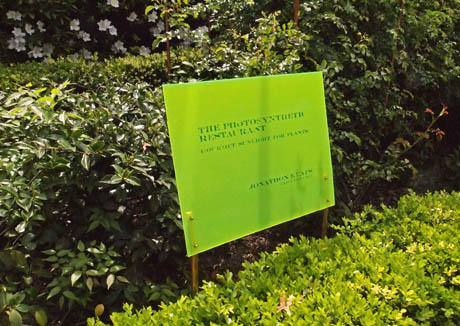
IMAGE: The Photosynthetic Restaurant sign, photo by Jonathon Keats.
Edible Geography: What goes into designing the look and experience of a restaurant for plants?
Jonathon Keats: Of course, the look of a restaurant depends on who’s doing the looking. From the standpoint of the plants, I don’t think they’re really going to be too bothered about the architectural elements. In fact, that’s how I feel as a human diner, although a lot of restaurateurs seem to disagree and create restaurants where the staging is more prominent than the culinary experience.
What I’m trying to do with the design of the restaurant is to make the experience of different frequencies of light served over the course of the day as seamless as possible for the plants. If you happen to be a human looking at how it all works, what you would see would be coloured acrylic filters mounted on copper poles that are planted on the ground. As the sun arcs across the sky, the light pours through the different colour filters, one after another. The physiological effect of different frequencies of light on the plants will form different courses of the meal and, ideally, will bring some sort of culinary enjoyment to the plants.
The whole thing is based on working with nature, as any good chef and restaurateur does. It’s classic California cuisine, showcasing fantastic ingredients — in this case, photons, freshly delivered from the sun — to their best advantage.
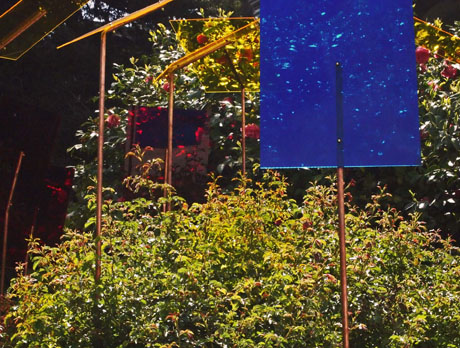
IMAGE: The Photosynthetic Restaurant, photo by Jonathon Keats.
The patrons will be out in front of the museum, in the garden. They’re elderly — they’re rosebushes that, I’m told, are more than 100 years old. Over the course of three months, my restaurant will be serving two different menus. Of course, each will be modulated ever so slightly every day because of the tilt of earth’s axis as it orbits around the sun. Working with seasonality is, I think, the essence of great cuisine, and I think the plants will appreciate this. At least, I hope that they do!
One of the menus will be what I kind of think of as hearty, healthy, well-balanced cuisine. In human cuisine, a hearty, healthy meal is a dish that serves up, in an enhanced and refined form, exactly what we need nutritionally speaking. You take the basic proteins and carbohydrates that Cro-Magnon man or Neanderthals would probably crave anyway, and then, because we have these incredible resources available that they didn’t, you can present each element in more forceful terms than they might occur in the wild.
The other menu is an avant-garde recipe. In that case, what I’m doing is playing against the expectations of the organisms that are my patrons. Just as in the case of human cuisine, when it becomes avant-garde, there’s an element of surprise and disrupted expectations, and what comes naturally is put out of order.

IMAGE: Menu Three in The Photosynthetic Restaurant Recipe Book “syncopates plants’ circadian rhythm by teasing their cryptochromes with a course of evening violet in the middle of the afternoon,” according to its creator, Jonathon Keats.
The pleasure in the hearty meal comes out of the fact that our expectations are fulfilled, only more so than they might be in the wild, whereas in the case of the avant-garde cuisine, which perhaps is a little bit more advanced in terms of what it requires of the patron, the pleasure comes from the element of surprise.
To create each menu, I’ve drawn on research into the physiology of plants. A lot of it was done by NASA, who were looking into farming on Mars, and some came from the Siberian Academy of Sciences, out of their practical need to try to feed people in the winter. The other big source of information was probably the most advanced people in the world as far as thinking about everything to do with cultivating plants: pot growers. They’re incredibly adept at these sort of things.
Of course, pot growers, Siberian scientists, and potential Martian farmers all share a common goal, which is to put plants even more in our service than they already are. They are giving plants meals that are meant to fatten them up in order for us then to consume them. It isn’t about the plants’ enjoyment at all. It’s about cramming in the calories, to use a human or animal equivalent, whereas what I’m looking to do is to give my patrons the sort of culinary experience that we enjoy when we go to a restaurant.
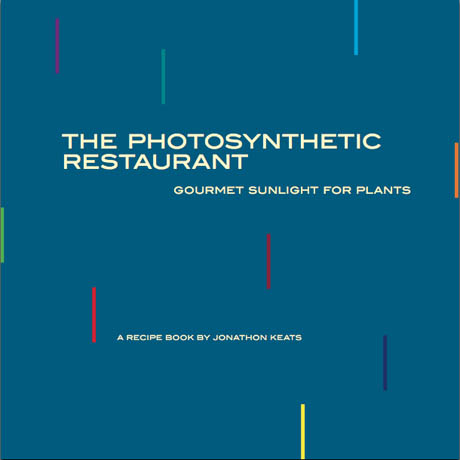
IMAGE: Cover of the The Photosynthetic Restaurant Recipe Book, by Jonathon Keats.
Edible Geography: You’ve also produced an accompanying recipe book, which showcases the healthy menu that “artfully accentuates qualities of unfiltered daylight,” and the more experimental menu, which, for example, will confound plants’ expectations by serving up evening violet in the afternoon. You also have an exciting-sounding third menu, which adds spice in the form of a hint of far-red light. Can you discuss these different colour ingredients and their sensory effects on plants? And did you have to translate the colours on your menu to make them visible to the human eye, which can only detect a narrow spectrum of light frequencies?
Keats: A plant perceives far-red light as a signal that there are other plants nearby, because the far-red part of the spectrum reflects off the leaves of plants. If you’re a plant, you don’t want others getting too close because then your sunlight is occluded, and so plants have a sort of fear response to the far-red part of the spectrum.
If you think about about habañero peppers or jalapeños or those sort of spicy ingredients, we get an enjoyment out of eating them, in spite of the physiological panic that they cause, because spicy cuisine brings about that sort of panic in a controlled way. It’s equivalent to catharsis in terms of theatre.
So, without anthropomorphising the plants, I’m trying to figure out what part of the spectrum I can use that will give them the sort of rush that we get from spicy food. And that far-red light is outside the reach of anything that we humans know that we are experiencing. It’s at the very end of the spectrum, where red shades into infra-red. In the recipe book, I’ve used inks that are the deepest of deep reds, in order to imperfectly, I will be the first to admit, express that part of the spicy menu.

IMAGE: Menu Two from The Photosynthetic Restaurant Recipe Book, showing the spicy far-red element of the meal.
Ultraviolet light is also part of plants’ everyday experience and an ingredient that I’m using in my cuisine. That deep-blue-into-violet-into-ultraviolet light, for instance, is a way in which plants seem to be able to perceive the end of the day. In the case of the hearty cuisine, I’m using it at the end of the day, almost in the way that a digestif works for us, perhaps. And, in the case of the avant-garde cuisine, I’m juxtaposing it with orange mid-day light. I’m playing a little bit of a sensory trick on the plants, in the same way that chefs preparing haute-cuisine throughout history have played tricks on their human diners.
Of course, humans are sensitive to these invisible parts of the spectrum too — for example, when we get sunburn. It’s just that we tend to think about light frequencies and color in terms of something that we see, whereas plants are used to detecting it through their entire bodies.
Edible Geography: In an interview with Wired, you said that “Cuisine is a form of communication, and mine won’t be complete until plants evolve a mechanism for food criticism.” I’m curious as to what extent you’re interested in measuring the plants’ reactions to the dining experience?
Keats: This is a gourmet restaurant. The last thing that I would want if I were in Chez Panisse would be for the waiter to come round with a stethoscope at the end of the meal. I do believe that there may, in the future, be fast-food chains devoted to plants, and they will probably hire scientists who will do all sorts of research to optimise their menus in order to entice plants.
In my case, though, I’m trying to work within the artistic tradition of gourmet cuisine. I’m attempting simply to offer the most enjoyable meal that I can.
I would also argue that even when those fast-food chains for plants come along, they are going to have a very hard time measuring the essential qualities of cuisine, which, for me, are qualities of enjoyment. You could argue that an fMRI could be used inside a restaurant. It would be loud but it could, eventually, be used as a way to measure our enjoyment of foie-gras or an eclair or whatever, so that you could start to build a data set of physiological responses to food. But fMRIs are really no better than stethoscopes, in that they are only an external view of enjoyment and the problem is that I don’t think that we really know what enjoyment is, ultimately. I don’t think that we know what pleasure is, in any quantifiable way.
And that’s part of what interests me in this project as an experimental philosopher, which, for lack of a better term, is what I am.
That is to say that, aside from being a restaurateur for plants, which I am, first and foremost in this project, what I am also attempting to do with my human patrons is to think about the world. A classic way to do that is through the thought experiment, where you posit an alternate reality as a way of then reflecting back on our world. My idea is not to do this on paper, as philosophers tend to, because nobody will read it except for a few academics. I’m trying to do what I believe philosophy was meant to do, and what I always hoped that it would do, and that, for me, entails trying to do a thought experiment in public and for real.

IMAGE: Menu One, the more traditional, hearty cuisine that simply accentuates the plants’ pre-cuisine diet, from The Photosynthetic Restaurant Recipe Book by Jonathon Keats.
So, in a sense, the Photosynthetic Restaurant is also a thought experiment, done with everybody who is interested and wants to be involved in it. By observing plants doing something that we do everyday — enjoying a good meal — it becomes a way of reflecting on a very strange thing that we do, which is to indulge in a variety of cuisines that, if you think about it, hardly conform to any rational ideas about how to get in a daily calorie count in the most efficient manner.
At one level, this restaurant is, I hope, a way of reflecting on this whole business of cuisine as a cultural phenomenon in opposition to food as sustenance — while at the same time thinking about how perhaps cuisine is actually the very essence of food as sustenance, both in terms of this practice of heightening and distilling the qualities of food as found in nature, and also in terms of how the social aspect of dining is what makes this sort of sustenance sustainable in its own right at a broader societal level.
All of these ideas are ideally in play, and at the same time, so too are broader questions, such as the nature of pleasure and the nature of what we are as a species and how we are different from all other species. Every benchmark of that difference that is currently in play is suspect for various reasons — crows use tools as well, dolphins recognise themselves in mirrors, elephants are altruistic, and so on. But there’s this idea that we have certain objective experiences such as elaborate cuisines and culinary enjoyment that seem to be special to us and our civillised state, and by exploring what that might be in a plant, it becomes a way of trying to figure out what do we mean when we speak about pleasure, and what is it that is special about us, if anything?
I don’t have any answers, of course, to any of this, but I think that they are fascinating questions, if people chose to engage with them.
Edible Geography: It’s also an intriguing framework to consider our commonalities, as well as what makes us different. In some ways, your restaurant for plants is an opportunity to think about the shared menu of light that we and plants are transforming into sustenance in different ways.
Keats: I hadn’t thought about it in that way, but you’re absolutely right — it’s interesting to think about what happens when we start to think about nature not in terms of a chain, or even a web, but in these aesthetically holistic terms.
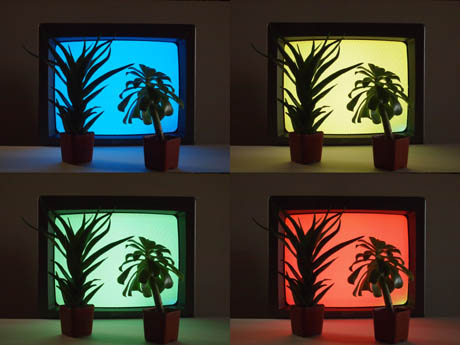
IMAGE: Houseplants enjoying their TV dinners. Photo by Jonathon Keats.
Edible Geography: In terms of the future of plant dining and fast-food franchises, do you have any idea what junk food for plants might be?
Keats: I have to confess that I’ve already moved into that territory a little bit. I’ve made a TV dinner for plants. It’s a meal that can be served to your houseplants on television. I filmed the sky through different colour filters and then made an hour-long movie that plants are able to consume. I’ll be exporting to Italy first — in a couple of months my TV dinners for plants will be available at an art centre called PaRDes in Venice.

IMAGE: These filtered skyscapes, filmed by Jonathon Keats, are the key ingredients in a houseplant’s TV dinner.
Edible Geography: That makes sense as a convenience food. I’m still wondering whether it’s possible for plants to deliberately eat as unhealthily as humans sometimes do. Do plants above the Arctic Circle, where they binge on sunlight for twenty-four hours a day in summer and then starve all winter, have the vegetable equivalent of anorexia?
Keats: The word “deliberately” in your question is the most interesting aspect of it. Plants do grow and “move” according to their “will,” such as it is. There is already something “deliberate,” as far as I understand the word “deliberate,” in the way in which the plants move, and so I think that perhaps the cuisine of the future for plants could be less imperious, and that chefs in the future will perhaps be a little bit less extreme than I am in terms of imposing my own artistic will on my patrons.
That might be a very interesting route to go, to create more of a photosynthetic cafeteria, where the plants, by virtue of their movement, are able to customize their dish as they wish. I’m sure you’ll then find some sort of behavior that is not going to be up to the standards of what nutritionists believe plants should eat. I don’t know exactly what they’ll choose, but it will be very interesting to see.
VIDEO: A short (three minute) version of the hour-long plant TV dinner that will be on offer at PaRDes this summer.
Edible Geography: One thing that is perhaps missing from the idea of cuisine in your restaurant for plants is the ritual around dining. Obviously, a restaurant for plants cannot and should not draw direct parallels from every aspect of a restaurant for humans, but, from the point of view of your thought experiment, were there elements of the dining experience that were untranslatable?
Keats: Things frequently transpose in curious and unexpected ways. I hadn’t thought about it in this way before, but there’s a sense in which our planet becomes the waiter, or a Lazy Susan, perhaps, in the Photosynthetic Restaurant.
There’s also a sense in which the ritual of dining becomes even more extreme in the case of the Photosynthetic Restaurant, because every day, it’s the same routine and there’s no other routine. There’s nothing else but the experience of having this meal. That can perhaps also serve as a part of the thought experiment, as a way for us to recognize the degree to which the ritual of dining is incredibly central to our lives. Even though in the human case, most of us are also doing other things, our breakfast, lunch, and dinner are somewhat analogous to the way that these plants are going through the same sequence, day after day.
I have to emphasise that that is inadvertent, which is interesting in itself. Perhaps it suggests something about how ritual is inevitable in the case of cuisine. Even in my attempt to get out of certain aspects of human cuisine, such as getting too involved in the architecture and staging, there are nevertheless certain qualities that are somehow essential to the dining experience that have worked their way into my restaurant.
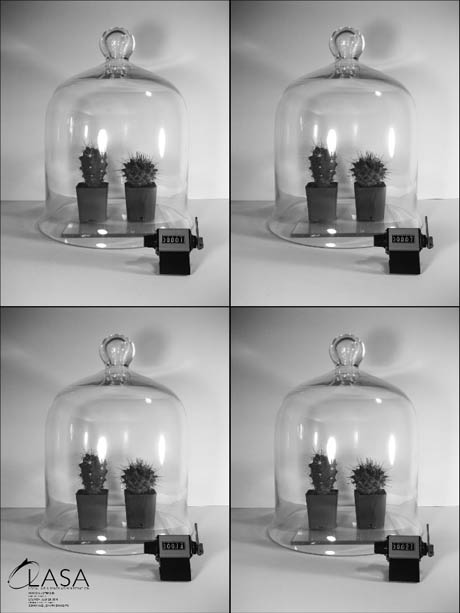
IMAGE: LASA, sending cacti into space since 2010, via Wired.
Edible Geography: With your alternative space agency, LASA, you turned potatoes and other plants into astronauts by growing them in water mineralised with lunar anorthosite and Martian shergottite. That project relied on a alternative mechanism of nourishment for plants. As far as I understand, plants can prioritise foraging for minerals in the soil or for light, depending on which is the most nutritious to them. In other words, they can send down deeper roots or grow more leaves, depending on which source is offering them the best diet. So, while your restaurant is serving light rather than soil, I could imagine an alternative restaurant that played with various menus of soil-borne minerals…
Keats: Which I hope you’ll open. They can be across the street from each other. We’ll let the plants decide.
Edible Geography: Alright! I was also curious, thinking about your previous plant work, which has included a porn theatre for zinnias, as well as some travel documentaries for house plants, as to whether you are intending to develop other genres of plant entertainment in the future — perhaps comedy for plants, or self-help for plants?
Keats: Absolutely — although I don’t want to impose myself so that people think that the only person for the job when it comes to keeping plants entertained or edified is me. I guess that, in some sense, I will have actually succeeded in my work if I’m put out of business by others doing much more interesting work for plants, and much more interesting thought experiments generally.
The reason that I have worked with plants as much as I have is that they have the enviable quality of being obviously different from us while at the same time being completely familiar. In terms of setting up a thought experiment, the plants are doing most of the work for me just by their very nature. That’s been the big draw in using plants as species with which to explore the world.
That said, I definitely don’t want to be entirely and only in the plant team. In the past, I’ve worked with honeybees to choreograph a ballet, and I’ve started developing textbooks for bacteria. Bacteria are a little more difficult because they are invisible to the naked eye, but they are so incredibly present in our lives that working with them also presents fantastic opportunities.
My current textbook project came out of the realization that, if you’re a bacterium, killing your host is not smart. I started thinking that superbugs are really bacteria that have gone rogue, and maybe — and this is really just a maybe — that might be for reasons that are similar to those claimed for crime levels in cities, i.e., for want of education. So I decided that I would try to educate bacteria, to see whether they might subsequently be more inclined to work with us rather than against us.
I’m making these textbooks as practical as I can for them. The first two are devoted to subjects that I think they will find as interesting as we do, namely general relativity and quantum mechanics. I’m using the phenomenon of chemotaxis, which allows many bacteria to sense the difference between salts and sugars. By using chemical gradients of salts and sugars on a piece of paper and engineering pathways with insoluble wax, I can deliver a curriculum to bacteria through capillary action.
VIDEO: Keats demonstrates the technology behind his textbooks for bacteria to Discovery Canada.
Edible Geography: That’s awesome. I’m guessing the next step will be mentoring these troubled bacteria, and finding them positive role models?
Keats: I believe the next step is that they’ll actually start to teach us, if only we are willing to learn. If you start to think about quantum mechanics, for instance, bacteria are at a small-enough scale that quantum phenomena are everyday occurrences for them. So what is so strange for us may not be at all peculiar for them, and they may be able to help us figure out a context to understand quantum events that is more intuitive.
Thanks to Andrew Price for passing along Keats’ press release. The Photosynthetic Restaurant will be open to plant patrons and curious humans until July 17; the accompanying recipe book (reproduced in part above) must serve, in Keats’ words, to “bring photosynthetic cuisine to the masses.”

